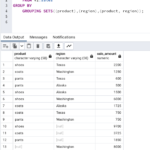There may come a time when you might want to shrink tempdb because it has become too large.
There are a few ways you can do this and I have listed them below but please read to the end of the post before making a decision on which way you want to approach this. There is an important note at the end of the post.
So first, we’ll look at the configuration on my server.
[sourcecode language=’sql’]SELECT name, size
FROM sys.master_files
WHERE database_id = DB_ID(N’tempdb’);[/sourcecode]
name size -------------------- ----------- tempdev 1280 templog 640 (2 row(s) affected)
Note that the size column is listing the size of the file in 8Kb pages. In this instance my “tempdev” file is 10Mb (( 1280 * 8 ) = 10240 kb)
How to shrink tempdb using DBCC SHRINKFILE
The syntax is as follows and the operation does not require a restart of the sql server service.
DBCC SHRINKFILE(logical_filename, size_in_MB)
So I will shrink the file to 5Mb
Here is the T-SQL:
[sourcecode language=’sql’]DBCC SHRINKFILE(tempdev, 5);[/sourcecode]
Which produces the following output and I can see that CurrentSize is now smaller than previously
DbId FileId CurrentSize MinimumSize UsedPages EstimatedPages ------ ----------- ----------- ----------- ----------- -------------- 2 1 640 288 176 176 (1 row(s) affected)
DBCC execution completed. If DBCC printed error messages, contact your system administrator.
name size -------------------- ----------- tempdev 640 templog 640 (2 row(s) affected)
Don’t try and increase filesizes in tempdb using this command because you will see an error. In this example, the attempt was to increase to 50Mb.
Cannot shrink file ‘1’ in database ‘tempdb’ to 6400 pages as it only contains 640 pages.
How to shrink tempdb using DBCC SHRINKDATABASE
The syntax is as follows and does not require a restart of the SQL Server service:
DBCC SHRINKDATABASE(tempdb, ‘target_percentage_of_free_space’);
So if the data files in tempdb had enough free space, you could shrink tempdb by running this command to leave 10Mb of free space at the end of the files:
[sourcecode language=’sql’]DBCC SHRINKDATABASE(tempdb, 10);[/sourcecode]
How to shrink tempdb using ALTER DATABASE
As in my post about moving tempdb, you can use the ALTER DATABASE command to perform a tempdb resize.
The following script will resize both the log and data file to be 100Mb.
[sourcecode language=’sql’]USE master;
GO
ALTER DATABASE tempdb
MODIFY FILE (NAME = tempdev, SIZE=100Mb);
GO
ALTER DATABASE tempdb
MODIFY FILE (NAME = templog, SIZE=100Mb);
GO[/sourcecode]
This operation requires a SQL Server service restart once the tempdb configuration has been set by ALTER DATABASE.
How to shrink tempdb using Management Studio
You can also use Management Studio to resize Tempdb and perform shrink operations by right mouse clicking the tempdb database and choosing Tasks->Shrink.
To resize tempdb, you can set the file sizes by right mouse clicking the tempdb and choosing Properties->Files and setting the sizes there.
Note that with both the ALTER DATABASE and management studio methods, you cannot resize a tempdb file to a particular size if the data contained in the file exceed the size that you are trying to size to.
Should you shrink TempDB?
It is documented in this Microsoft article that it can cause consistency errors in the TempDB database if you perform a shrink operation while the database is in use so please read this carefully and consider whether you can shrink the database by other means, i.e restarting the SQL Server instance which will create a brand new copy of TempDB releasing the disk space.
Tempdb won’t shrink?
I sometimes get asked about why tempdb won’t shrink when using one of the methods which does not involve a SQL Server service restart. Microsoft recommends that if possible, shrinking of tempdb should be done either in single user mode or when there is no current tempdb activity. I have extracted the quote below from the article that is linked to in the previous section.
It is safe to run shrink in tempdb while tempdb activity is ongoing. However, you may encounter other errors such as blocking, deadlocks, and so on that can prevent shrink from completing. Therefore, in order to make sure that a shrink of tempdb will succeed, we recommend that you do this while the server is in single-user mode or when you have stopped all tempdb activity.


This was very clear and informative. Thanks!
Hi Gary
Glad you found the article useful. Thanks for your comment.
All the best
Andy
Perfect…very nicely put through which helped me getting the information out in no time.
Thanks for your suggestion!
You saved me from the fires of hell! LOL
Great! I’m glad it helped 🙂
Very, informative article.
Very Nice
Dear All
This article is not working for me, my tmpdb is taking 60{3a76cbff1b5ce5ace3bd34bbdd68f71285d81fb9af60114c7a6db80d3a8688de} of memory. please help if you can share anything.
Hi, I tried ALTER command to reduce the data file size and it was perfectly worked-out. But the problem is when I check the data file size it is showing 5MB & log file also 5MB. But when I checked the database size in DB properties it is showing as 3 GB also same in physical data file size. Please shed some light on this.
Your Command was very simple and it really helped me to reduce the tempdb size.
Great Article, there i found very informative article why to prevent shrinking of data files
Great Article, there i found very informative article why to prevent shrinking of data files:
http://www.sqlmvp.org/do-not-shrink-your-data-files/
nice……….
Yesterday I was in a critical situation due to Temp DB drive was full and somewhere I read it is not recommended to do shrink the temp.
Finally, this post helped to shrink temp DB.
Thanks for sharing your thoughts about tempdb. Regards